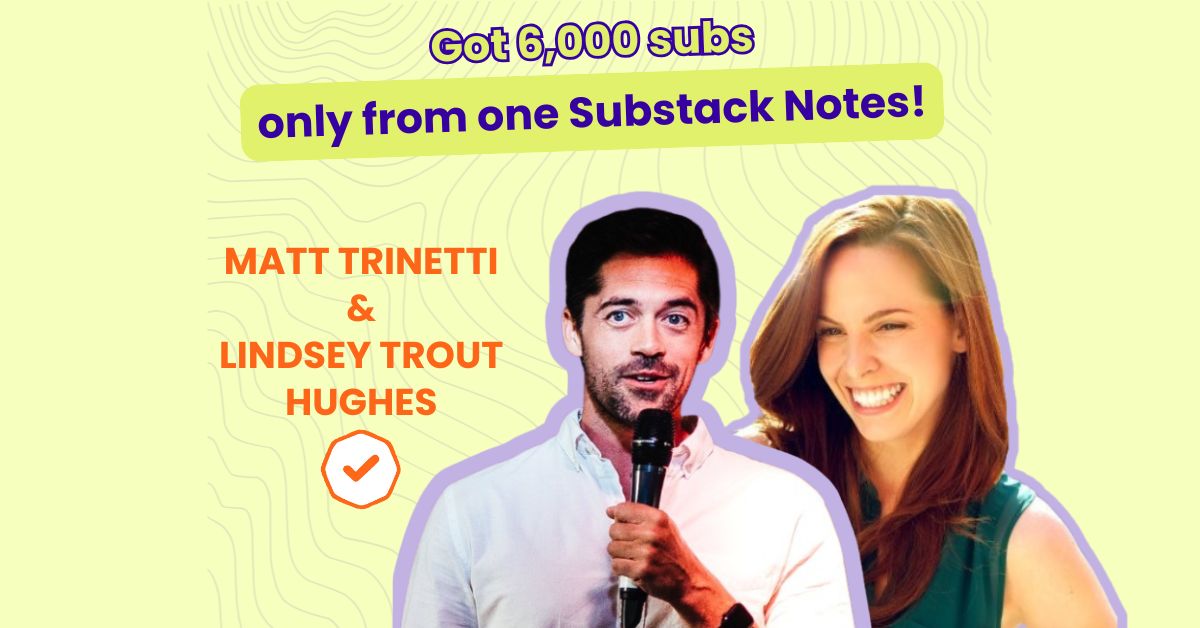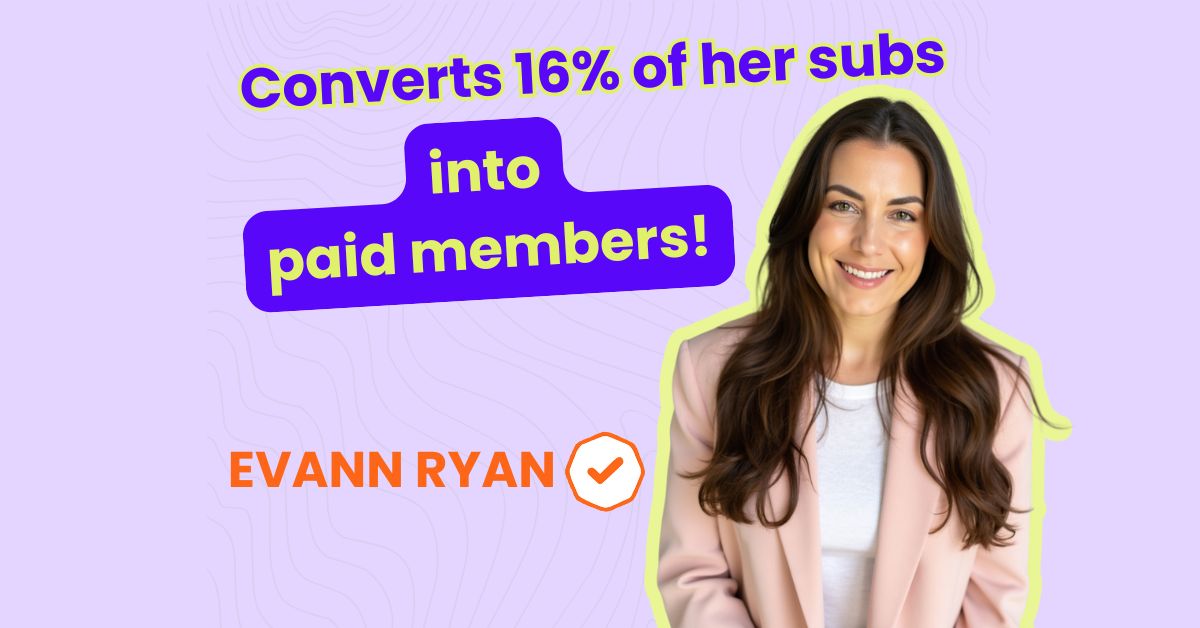Interview Date: May 25, 2025
Table of Content
- Meet James Lavish
- Newsletter Identity Card
- Tools he uses to run his newsletter
- Why he started his newsletter
- How he grew over 41,000 subcribers
- His paid subscription strategies to reach 1,100 paid members
- Personal & professional impact of running a newsletter
MEET THE CREATOR
In 2021, James Lavish, a seasoned institutional investor began writing simple, clear breakdowns of complex financial topics, first on Twitter, then in a newsletter he named The Informationist. Started with just one subscriber (his wife!), then quickly grew into a must-read Substack publication, now followed by over 41,000 readers and more than 1,100 paid members.
What makes The Informationist stand out? It’s not flashy marketing or secret growth hacks. It’s a consistent value delivered with clarity, depth, and a mission to make readers financially smarter.
In this interview, he shares:
- How he grew from 0 to 41K+ subscribers in less than 3 years
- The viral moment that changed everything, and how podcasting became a key growth engine
- Why he left Substack, switched to ConvertKit, and ultimately came back
- The mindset shift that helped him build a thriving paid subscription
- What he’d do differently if he were to start over (hint: patience is underrated)
Enjoy!
NEWSLETTER IDENTITY CARD
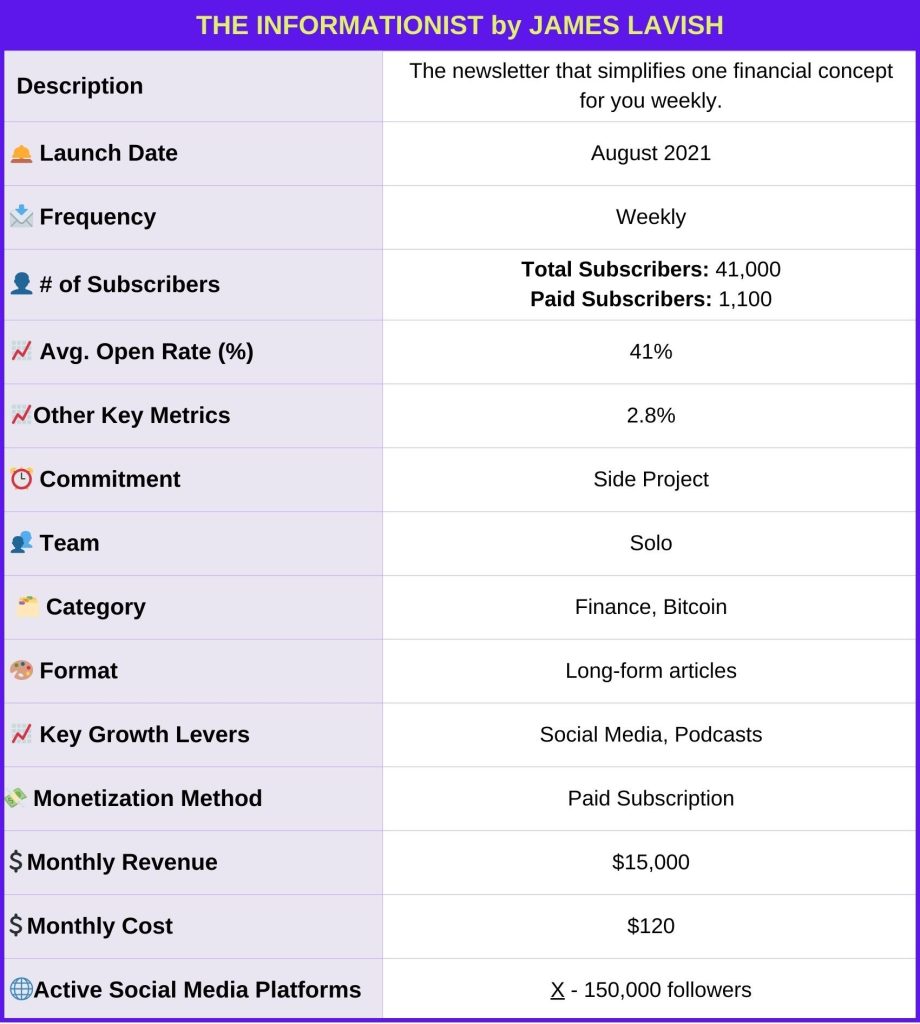
TOOL STACK
- ESP: Substack
- Research: Bloomberg, ChatGPT
- Charts: TradingView
- Note taking: Notion
- Visual design: Adobe Photoshop
- Payments: Stripe
START
How and why did you start The Informationist in the first place?
It was actually pretty simple. I had been sharing information on Twitter (currently X) about the financial world, macroeconomics, and investing, all from the perspective of a long-time institutional investor.
I quickly realized how there was a deep need for a newsletter that made all these concepts super easy to understand. And so, I created a Substack account, started writing about these concepts weekly, and the Informationist was born.
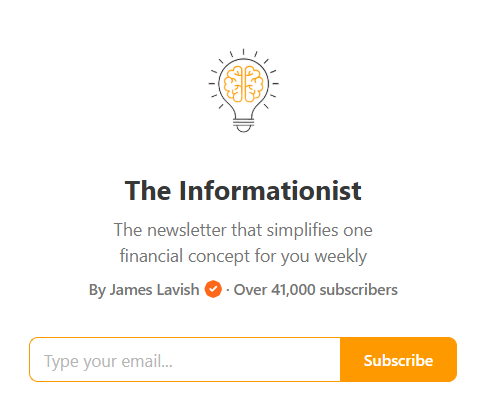
GROWTH
Which strategies did you use to grow over 41,000 subscribers in less than 3 years?
0 – 1,000 Subscribers
I started to just share the newsletter concepts and driving traffic to it from Twitter, and so this was a slow build from just a few friends and family readers.
I actually had one subscriber in September of 2021, my wife, and it took me all the way to January 2022 to reach 100 subscribers. From there, it accelerated a bit, and I eventually hit 1000 subscribers in April 2022, just a few months later.
1,000 – 10,000 Subscribers
I continued this strategy of just sharing and driving traffic from Twitter. With the newsletter still free, I was just sharing as much as I could. Then I started writing long threads on Twitter that mirrored past newsletters, and this started to really drive traffic to Substack for me.
Then, in August 2022, I wrote a piece called the Debt Spiral which ended up going viral on multiple platforms. This led to my big break, where I was invited to be a guest on a few large financial podcasts, and my subscribers jumped to over 3,000.
By September 2022, my subscribers exploded to almost 8000, and that momentum just continued to carry me over 10,000 in just a month. I had no real strategy here; I just kept joining more and more podcasts to discuss that newsletter and other concepts, and it all just snowballed in a kind of fury.
10,000 – 30,000 Subscribers
By this point, I was a regular guest on numerous podcasts, and The Informationist just kept growing organically. Because the newsletter was taking up more and more of my time, and I wanted to continue to do it, I made the tough decision to create a paid gate, which gave paid subscribers access to all weekly newsletters, not just one free newsletter a month.
And then, in the Spring of 2023, as I was around 15,000 subscribers, Substack and Elon Musk got into a very visible disagreement about how Substack was using Twitter information. Suddenly, any post that included a link to Substack was shadowbanned on Twitter.
It was so bad, that some Substack writers just left Twitter altogether. As for me, I had recently left my old hedge fund and was fully focused on making a career in this new space.
This is where I had a major misstep. I left Substack and moved The Informationist to ConvertKit.
The idea was to create multiple offshoot newsletters from The Informationist with different levels of membership. I hired a marketing firm to help grow my readership at this point. But I did not want to simply acquire readers, but rather ensure that it was still healthy organic growth. This actually worked quite well, as The Informationist’s open rate continued to be over 40% each week, even as it grew rapidly.
However, I had just launched a new hedge fund, and it was clear that this path with ConvertKit was just too much work for me. And so, just as I hit 30,000 subscribers, I made the difficult decision to head back to Substack in the spring of 2024. I knew that their platform was just far simpler, and the organic growth engine they had built would solve my time and growth issues in one fell swoop.
30,000+ Subscribers
Now back at Substack, with just over 30,000 subscribers, I returned to first principles and the whole reason I launched The Informationist in the first place: To simplify complex financial topics for any reader to understand. And to make people smarter and to give them the tools to protect themselves financially.
Now, there’s only one newsletter, the original Informationist, and there is a free version and a paid version. The free version includes one free full newsletter per month, and the paid version includes four per month, one newsletter every Sunday.
The Informationist has continued to grow steadily, with bursts of new subscribers when the newsletter touches on something very timely or of great interest to many people. I now have over 40,000 subscribers, and it continues to grow every day.
I’m super grateful for the success of the newsletter, and I love writing it every week. We even have a little bit of a community in the comments of each newsletter now, which I participate in too.
You have an impressive audience of 150,000 followers on X! (see here) How has that platform contributed to your newsletter growth? What’s been the most effective strategy for turning your X followers into newsletter subscribers?
As I said, Twitter was a critical part of the early growth of The Informationist.
The thing is, my Twitter account grew alongside the newsletter. This was due to being very active on the platform and sharing a ton of information, insight, and experience from my 30 years on Wall Street.
I also wrote long threads simplifying all of these concepts, just like the newsletter. Every time I would write a long thread, I would get hundreds and sometimes thousands of new followers on Twitter.
When I returned to Substack, I stopped writing long threads like that and kept those types of explanations in my newsletter only. And so, since I have returned to Substack, Twitter has been much less important and effective as a growth tool.
That said, both The Informationist and my Twitter growth continue due to me being a regular guest on numerous podcasts, as well as being a guest on or being quoted by Fox Business, Bloomberg, CNBC, and Yahoo finance.
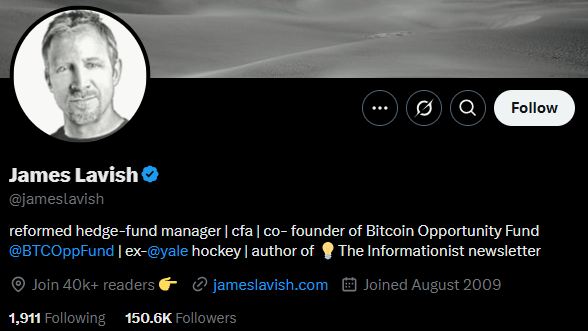
MONETIZATION
When did you launch your paid subscription, and how did you decide that it was the right time for you to activate it? How long did it take for you to become a Bestseller?
Like I said, I kept the newsletter free for as long as I could. But, needing income and still wanting to continue to write the newsletter—I really do love it—I decided to create a paid gate for a premium version in early 2023.
It surprisingly didn’t take too long for me to jump into the top 100 paid financial newsletters. In fact, it was almost immediate, and the Informationist was in the top 50 paid financial newsletters before I left for ConvertKit.
When I returned to Substack, I lost some ground at first, falling out of the top 100. That said, The Informationist is now back in the top 50 again.
Which strategies did you use to reach 1,100+ paid subscribers?
0 – 100 Paid Subscribers
This was easy, as I already had over 15,000 free subscribers. When I turned on the premium paid newsletter, I immediately had over 100 paid subscribers.
100 – 1,000 Paid Subscribers
This was a much longer road. But the strategy was simple: make sure that the one free newsletter per month was absolutely outstanding. This way, readers who had been reluctant to pay for the full version would be compelled to subscribe.
I should note that free subscribers still receive a newsletter every week, but they only see about 1/3 to 1/2 of the paid versions. There is a paywall that they have to be a paid subscriber to see the rest of it.
Now, I often get the comment that the free newsletter from the previous week compelled a reader to hit the buy button and become a paid subscriber, and they just wish they had done it sooner. I love hearing this, because it means that I really am delivering something that is valuable to them.
1,000+ Paid Subscribers
This is kind of where I’m at now, and my strategy remains exactly the same. I’m just growing organically and focused on delivering the absolute best content I possibly can. That said, I may hire someone in the future to help get The Informationist in front of more eyeballs. We will see about that.
Among various strategies you’ve tried so far, which ones work best to grow your paid subscribers list?
The most effective strategy has easily been to give away the best content you possibly can, show people what they’re missing, and then entice them with part of a paid newsletter with a paid gate to read the rest.
I find that when I then run a special annual-rate discount, I get many new paid subscribers who had been waiting and now felt that they couldn’t pass up the opportunity of the deal. I run these discounts a few times per year now, and they’re extremely effective.
How did you decide what to offer differently to paid subscribers to make it compelling for them to join as paid members?
The paid newsletters are typically a little bit more in-depth with strategies that I am employing myself for my own portfolio, as well as ideas for readers to use themselves.
Again, it is a super simple concept for conversion: show them what they’re missing and entice them to hit the buy button to keep reading the rest of the paid newsletter.
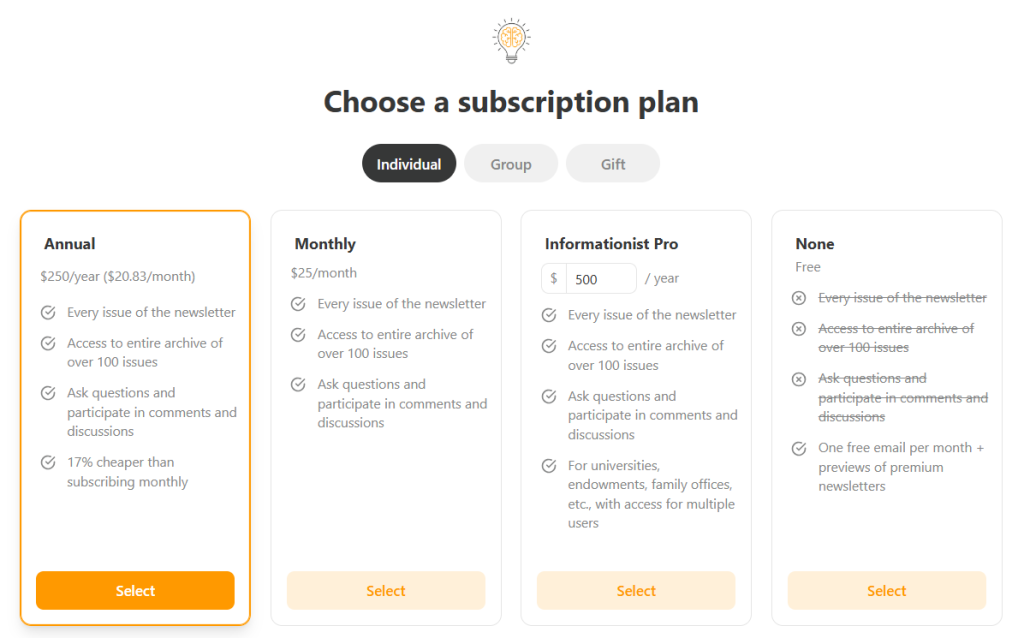
What are the biggest lessons you’ve learned from running a successful paid subscription? What would you do differently if you had a chance to start over?
I’d say my biggest lesson has been to keep it simple, to keep it focused, and to be patient with the paid growth. I understand now that newsletters grow not just from readers seeing me on Fox News or a podcast, but rather by having it sent to them by one of their friends. This is often the most effective form of paid growth because it has a built-in testimony to it.
If I had to start all over, I would have never left Substack, and I would have only focused on The Informationist, not of any of the offshoot newsletters. I would have been more patient and saved myself a whole lot of aggravation, effort, and time.
IMPACT & LEARNINGS
How did building The Informationist newsletter contribute to your life professionally and personally?
The newsletter has absolutely helped me be in the position to launch my hedge fund. Being so active on Twitter and writing every week has exposed me to many people who would never otherwise know who I am or what experience I have. On top of that, I get great satisfaction in making people smarter, especially in this incredibly important part of their lives, finance.
What would you do differently if you had a chance to start over The Informationist?
I’m not sure I would have done anything differently, except like I said, be much more patient with the paid growth.
What would it be if you had the right to give one piece of advice to aspiring newsletter creators?
I’d say the most important advice for an aspiring newsletter creator would be to be consistent and show up regardless if anybody is reading yet. Because if what you’re writing is good, they will arrive sooner or later.
3 Popular The Informationist Issues
- The Dangerous Hedge Fund Basis Trade
- The CBO and Taking the Treasury’s Debt Temperature
- Can a Treasury Auction Fail?
Where to find James Lavish
- “The Informationist” Newsletter
- X

